
Transforming the power of waste
The DVO Two-Stage Linear Vortex™ anaerobic digester is a patented system for processing biowaste on farms, agribusinesses and commercial/industrial facilities. It greatly reduces odors, is cost-effective, scalable, operates automatically and requires low maintenance.
- No other digester design comes close to its biogas/renewable energy output and greenhouse gas emissions reductions.
- DVO changes valuable nutrients (NPK) such that they are readily usable by farmers for fertilizer—even on growing crops!
- Optional technologies (NR and PR) convert nitrogen and phosphorus into condensed and stable products—enabling the processing of unique waste streams, such as poultry manure and litter.
- DVO is the only digester that enjoys “Recognized” status by the independent agency Newtrient, LLC.
A Unique Design
DVO linear vortex systems are in the general category of “mixed plug flow digesters,” but our design is unlike any other. Through a non-mechanical process, the digester creates a vortex in the waste as it moves through the digester. This ensures biowaste entering the digester is thoroughly mixed and processed to extract the maximum amount of biogas and elevate the quality of byproducts.
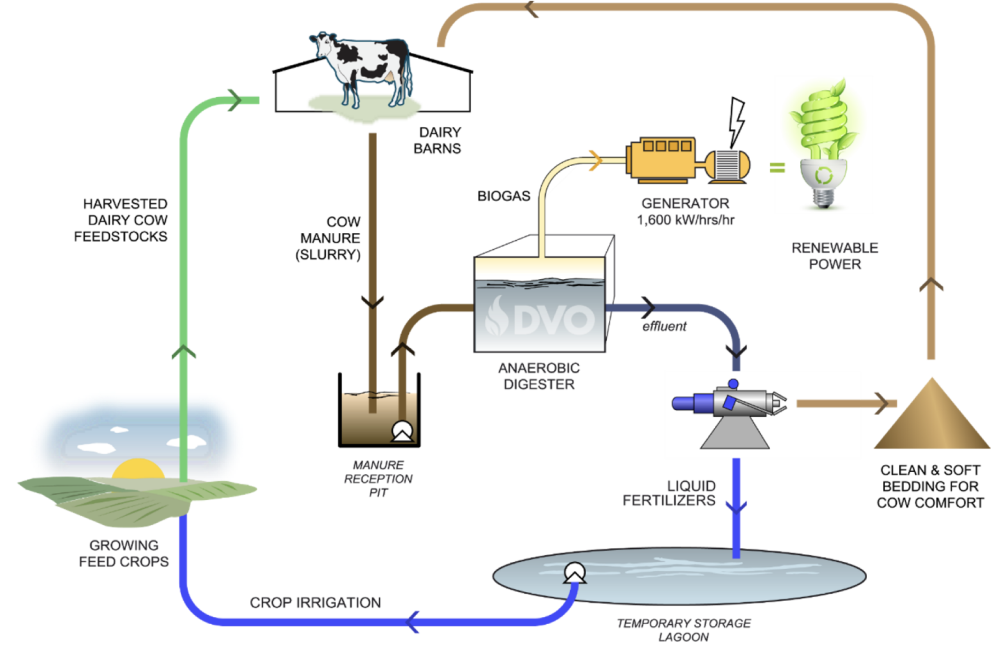
Guaranteed Retention Time
Every ounce of waste entering a DVO digester has a guaranteed retention time. This means waste is not under processed or over processed. It’s processed for the optimal amount of time to fully digest waste but no longer than that.
This feature is key to the efficiency and effectiveness of our system.
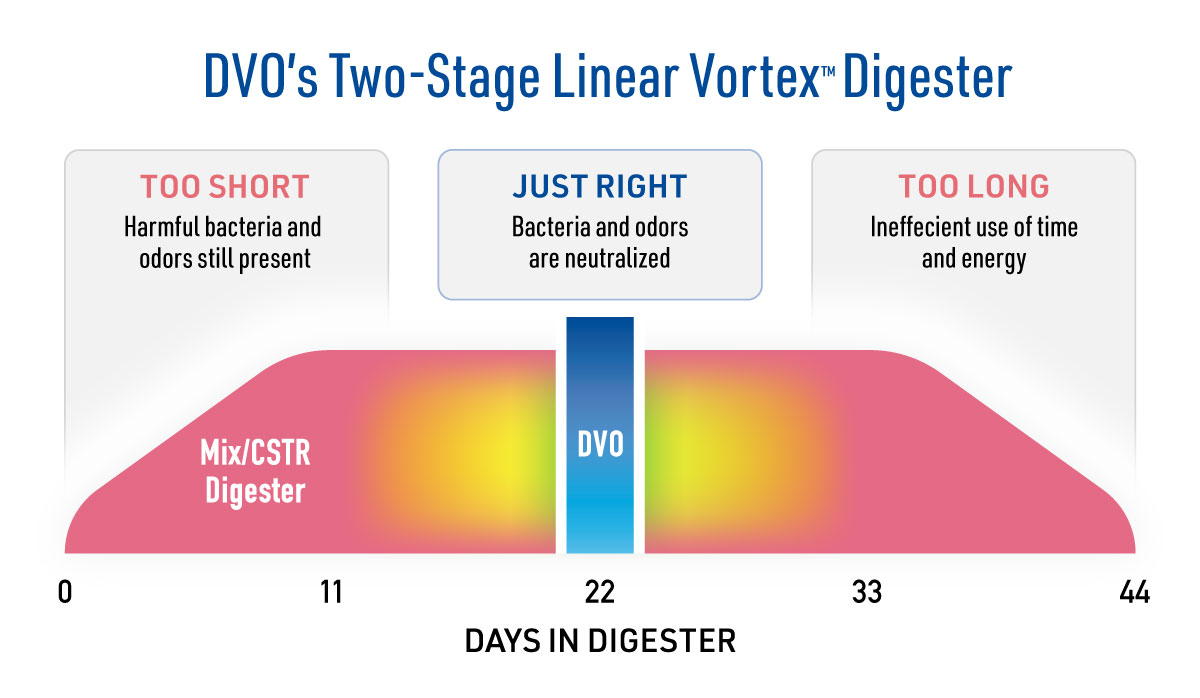
Guaranteed retention time delivers:
 More biogas = more revenue
More biogas = more revenue
All waste is fully processed anaerobically.
 Odor Control
Odor Control
Biodegradation is thorough, so the smell is removed and doesn’t come back.
 Pathogen destruction
Pathogen destruction
Waste is kept in the digester longer than the 12 to 14 days required to kill pathogens.
 Environmental Benefits
Environmental Benefits
Byproducts, like fertilizer, are transformed to an inorganic state and ready for use without fear of polluting.
 Healthy Cows
Healthy Cows
Processed solids used for bedding are virtually pathogen free, helping with mastitis control.
Add On Technologies
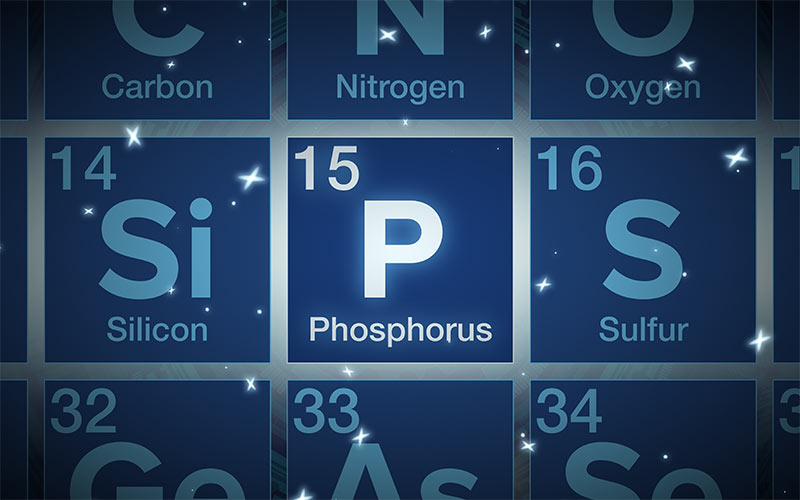
Phosphorus Recovery
By treating wastes in the patented DVO 2-Stage Linear Vortex™ anaerobic digester, and then employing our Phosphorus Recovery (PR) system, it’s possible to conserve valuable minerals and help protect our natural resources.
Learn more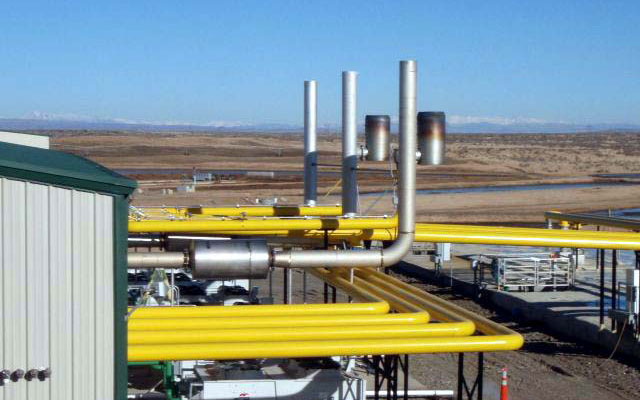
Nitrogen/Ammonia Recovery
The DVO system uses a natural, non-chemical method to further process waste and remove ammonium/ammonia. It also captures ammonia and converts it to a stable and marketable form. This creates another revenue source or operating cost offset for the digester.
Learn moreDVO vs the Competition
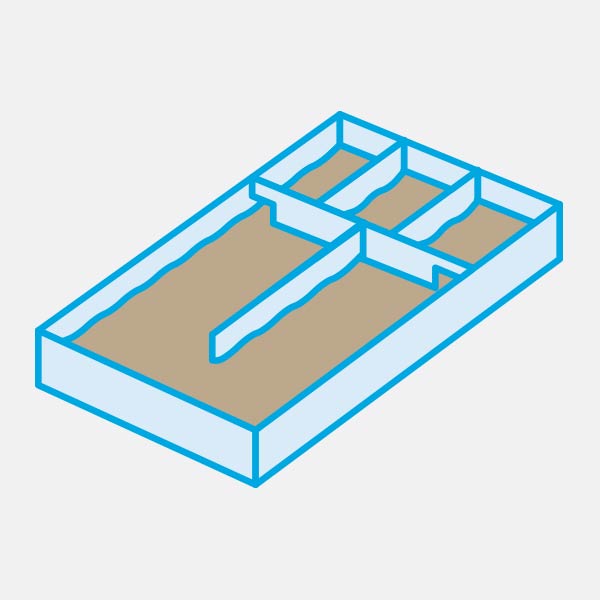
DVO Two-Stage Linear Vortex
Fully processes waste through a guaranteed retention time. Waste is thoroughly mixed through non-mechanical means and heated to an ideal temperature.
- Configured for each site and waste stream so it is completely scalable.
- Waste heat can be captured and used at the operation.
- Mixed plug-flow means first waste in is first out.
- Requires minimal maintenance and below ground construction ensures durability.
- Handles a wide range of waste streams with either high or low solids concentrations.
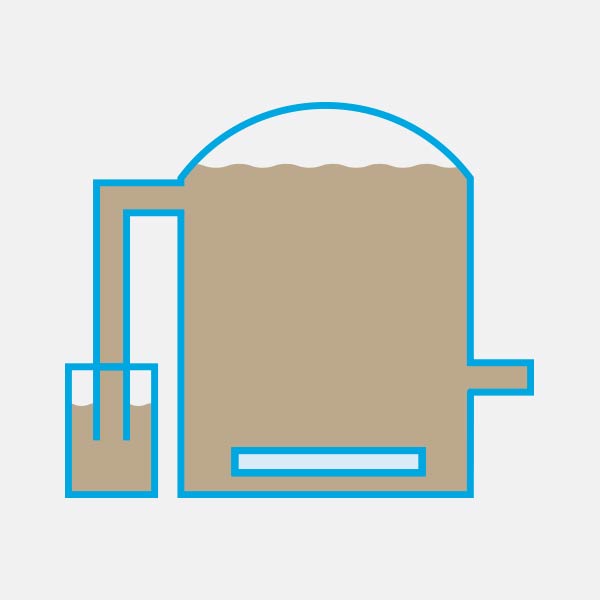
Complete Mix/CSTR
A complete mix or CSTR digester is basically a tank in which manure is heated and mixed with an active mass of microorganisms. Incoming liquid displaces volume in the digester, and an equal amount of liquid flows out.
- Some fresh waste can go straight from entrance to exit, and some stays in longer than necessary.
- Valuable methane forming microorganisms flow out of the digester with displaced liquid.
- Works best when waste stream contains 3 to 6 percent solids.
- Lower solid concentrations require a larger digester to retain microbes in the digester for 20 to 30 days.
- Above ground tanks can and do fail.

Covered Lagoon
Covered lagoons are a passive system in wide use, primarily because they appear to be a cheaper option. However, savings are minimal, and the real cost comes in lost biogas production.
- Does a poor job thoroughly mixing and digesting waste, resulting in lowest biogas produced.
- Lagoons accumulate solids and must be cleaned out regularly.
- Does not work well in cold environments as low temperatures inhibit digestion.
- Byproducts require further processing before they can be utilized.
Digester Type Performance Comparison
| Two-Stage Linear Vortex™ | Complete Mix | Covered Lagoon | |
|---|---|---|---|
More biogas means more D3-RIN revenues per cow | 115 | 80 | 50 |
Design generation | 3rd | 2nd | 1st |
Plant longevity (avg years) | 30+ | 15-30 | 5-10 |
Lowest cost per MMBtus output/time | Best | Poor | Poor |
Preferred by farmers | Best | Poor | Poor |
Can process 100% of food/organic waste | Best | Okay | Poor |
Performance is not “seasonal” | Best | Best | Poor |
Ability to divert all VS from lagoon storage | Best | Poor | Poor |
Processes more dairy waste than any other | Best | Poor | Poor |
Flush, scrape and vac-collection dairies served | Best | Okay | Best |
Superior animal bedding quality | Best | Poor | Poor |
No composting of solids needed | Best | Poor | Poor |
Pathogen destruction (e-coli, salmonella, etc.) | Best | Okay | Poor |
Odor and weed-seed destruction | Best | Okay | Poor |
Methane emissions avoided per cow | Best | Okay | Poor |
Greenhouse Gas (GHG) impacts avoided | Best | Okay | Poor |
Renewable power generated per ton of waste | Best | Okay | Poor |
Positive carbon footprint | Best | Okay | Poor |
Digester is certified “Newtrient Recognized” | Best | Poor | Poor |
Efficient, optional ammonia recovery step | Best | Poor | Poor |
Suitable for co-generation (e.g., food waste and manure) | Best | Okay | Poor |
| Download PDF |
How It Works: Two-Stage Linear Vortex
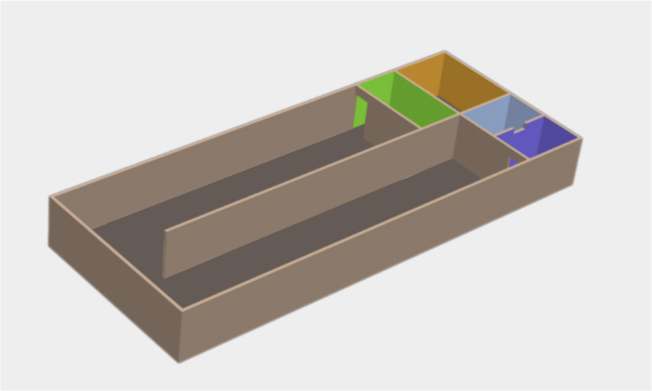
Below-Grade Vessel
Using local contractors, the vessel is built below ground. This helps maintain an even temperature to optimize bacteria growth. It’s much stronger than steel tanks, which have been known to freeze and even rupture.
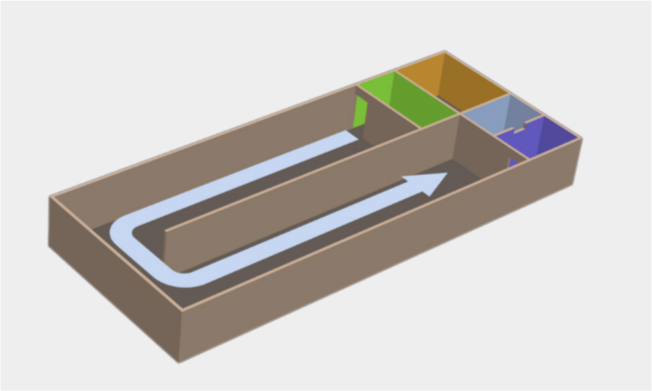
Mixed-Plug Flow
Waste enters the digester and moves to the pre-heat chamber. Methane is collected from the first two stages and utilized for fuel in the combined heat and power gensets.

The Vortex
Biogas is taken from the headspace, compressed and injected into the digester in a way that’s not mechanical but creates a lifting movement in the waste. This results in the linear vortex and thoroughly mixes waste.
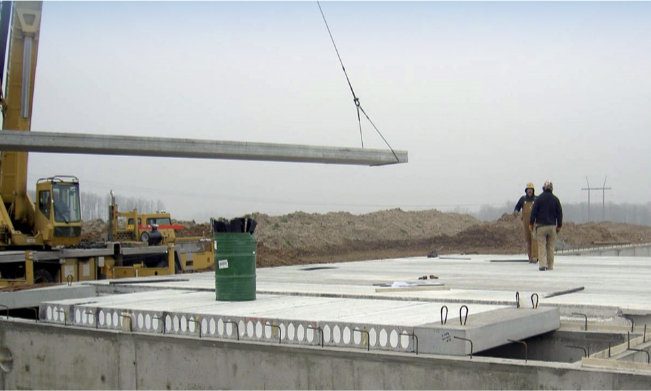
Hard, Insulated Top
The digester is covered with a hard, insulated top. This holds in heat and creates an extremely strong, durable vessel. Thickness of the vessel is adjusted for local conditions.
DVO Digester Products
RNG/CNG
DVO digesters create renewable natural gas (RNG/CNG). Scrubbing equipment goes in after the digesters to prepare the gas for use. The biogas produced is about 58% methane, which is essentially natural gas.
Electricity
Electricity can be produced by generators that burn the biogas as fuel. This was once the primary use for biogas. New incentives are coming online in the marketplace that may once again make renewable electricity a core product.
Liquid Fuels
Hydrogen fuel cells and renewable liquid fuels are starting to get more interest in the industry. One new facility will produce renewable diesel fuel with the biogas that the DVO system produces.
Fiber Solids
Separated solids may be utilized by the farm for animal bedding or sold to other farms or to after-markets, such as nurseries and composters, for soil amendment material.
Plant-ready Fertilizers
Nitrogen ammonia can be recovered and placed in the form of a stable commercial fertilizer. Up to 90% of phosphorus can be economically captured in a form that is economical to transport to the land.
Odor & Pathogen Destruction
The DVO digester metabolically breaks down organic waste streams, providing a 97 percent reduction in odor…and destroying nearly all aerobic pathogens (such as e-coli and salmonella), often to the point of non-detection.
Additional Resources
Related Frequently Asked Questions
How do I get started?
With only a few basic pieces of information, namely:
- What is being processed (data such as TS, TSS, pH are helpful too)
- Daily volumes (max)
- Timeframe (when desired)
We can estimate both the capital and operating costs. Melissa VanOrnum, 920-418-4543, will be glad to help you investigate at no obligation.
Why has DVO’s patented “Mixed Plug-Flow™” design become the U.S. market leader?
Our system substantially outperforms the other technologies such as "complete-mix" and the even older "plug-flow" (non-mixing) systems... by producing more biogas per unit of feedstock, more efficiently and with reduced maintenance costs. It is also maintains a more robust and stable operation. Owners appreciate that DVO digesters are designed to be operated and maintained by their own staff, not requiring trained technicians.
What are the advantages to having a hard, insulated concrete top vs. the “soft top” seen on earlier designs?
- For one, concrete lasts a long, long time. Soft tops can be damaged (by high winds/lightning/storms, by the sun’s UV rays, by farm tools/implements etc.) and sometimes need to be completely replaced.
- Heat mostly wants to escape through the top (which is why we wear hats in winter). A better insulated concrete vessel means reduced energy required to maintain the correct temperatures = higher operating efficiency = higher performance. Soft tops can sometimes be cheaper to install initially, but because of this loss of operational efficiency soft tops cost much more over time ─ even if you are fortunate to not have to replace them due to damage.
- Our concrete cover does not have to be removed should the digester ever need to be emptied or cleaned out (i.e. for a planned expansion of capacity). Vessel accessibility is built into our design.
Is your “Guaranteed Retention Time” also one reason why DVO digesters produce more biogas using the same feedstocks, than other designs?
Yes. And also why we see better odor reduction and pathogen control.
Why do DVO digesters see a much better pathogen reduction than the “complete-mix” or “plug-flow” designs?
3rd party figures are publicly available (see above-referenced "EPA - Gordondale" report available on our website) where others typically do not. For pathogens that cause farmers problems such as E-coli and salmonella, we see a 97-99% removal. Often lab reports come back "none detected." This is only possible because our design offers a guaranteed hydraulic retention time (HRT) -- which means every unit of waste that goes into our digester is retained and processed for a guaranteed number of days. In a complete-mix digester this is impossible. Some waste leaves the system too soon (waste not fully digested will contain many more pathogens, and energy not harvested), and some is also left in and processed longer than necessary, which reduces system efficiency. And, you can't kill the same pathogen more than once.
DVO minimizes using mechanical mixers in favor of a proprietary, patented biogas recirculation system. Why?
Mechanical mixers require more energy to adequately mix the same amount of liquid, which reduces the output and efficiency of the system. Furthermore, anything that is more mechanical and complex is inherently less reliable and will require more maintenance.
Are financial grants available from my state?
Some states offer grants. We can determine if you qualify and help you apply for them.
Are financial grants available USDA (Federal)?
Yes, and we can assist you with the application process.
What will my utility pay for the electricity?
This will differ greatly from state to state, and region to region.
Is it possible to store biogas and generate power during peak hours only?
Yes it is — when it is economically practical to do so. But that is not typical. To take advantage of a higher peak rate one must install 2-3x the power generation equipment (to burn the gas created during off-peak hours in a shortened timeframe) — which engines will also then be cycled on/off and idled daily. Cycling engines is hard on them and as a result their maintenance costs also increase. In short: When the financial return of biogas storage more than covers significant additional capital and operating expenses, DVO can provide this capability.
Can I add additional energy substrates to my digester? Such as food wastes?
Absolutely. DVO's unique 2-stage "Mixed Plug-Flow™" design actually does a more thorough job of processing food wastes and other energy substrates, compared to complete-mix/CSTR and other digesters. This is partly due to our guaranteed retention time. — namely, waste does not leave the system "too soon". For this reason DVO also does a better job of pathogen and odor destruction. However, before adding any substrate for the first time we recommend a lab analysis be performed on a sample to ensure that there are no bactericides, high salt concentrations, etc. that might disrupt the digestion process.
Will the digester take in ALL my biowastes?
Yes. They are designed to accept a wide variety of organic wastes, with a range of solids content.
What does it cost to install?
The installation cost is relative to the volume of waste to be processed daily. The particular characteristics of any waste stream can also influence system design and cost as well. Some upfront testing is usually desired.
Is PR easy to operate?
Yes. Like our digester, Phosphorus Recovery is designed to operate automatically and with minimal supervision.
Do I need a DVO digester? Or will any digester do?
As digester designs differ, so can their performance. Partly because a DVO digester's unique design offers a "guaranteed retention time," waste streams are more thoroughly processed than with other AD designs. The benefit is both a higher level of Phos removal and more economical operation.
DVO is initially rolling Phosphorus Recovery out to its customers, but may also offer this process to other AD owners at a later date (TBD).
Do I need a digester for this to work?
Yes. Waste streams that are anaerobically processed first enable us to concentrate and remove phosphorus economically.
Can this process be applied to co-digested, mixed-waste streams?
Yes. For example, phosphorus recovered from urban organics can be diverted from landfills. The PR system can accommodate a high-degree of input variability.
How do I know yours is a good design when everyone else claims theirs is “the best available?”
- Don't take our word for it. The U.S. EPA keeps track of U.S. farm digester installations: https://www.epa.gov/agstar/livestock-anaerobic-digester-database Download this Excel spreadsheet, sort it by the "System Designer" column, and you will see how many DVO has sold in the previous few years (versus competing systems). You will also see repeat DVO customers – a key indicator of customer satisfaction.
- Talk directly to our customers. Any of them. Unlike others we don't provide a "referral sheet." Our customers are our best salespeople, and we encourage you to ask them about their experience with our system. For example, in the dairy industry some of the largest and most respected names (such as Fair Oaks, Bos, and Bettencourt) and operations of all sizes and configurations (scrape, flush, vac, sand etc.), employ our system.
- Compare actual performance figures. It's hard to find complete and accurate performance figures from other companies, especially for manure waste streams that do not contain any substrates (conveniently making valid apple-to-apple comparisons impossible). The EPA commissioned an extensive study at one of our sites, our first built – and the results are available here.
Why do DVO’s biosolids have the reputation of being an excellent bedding material for animals?
Our guaranteed hydraulic retention time means all waste is uniformly processed, and none leaves the vessel too soon. In a Complete-Mix/CSTR digester, some waste leaves too soon, leaving food for bacteria, odor and pathogens. Some also remains longer than desired, decreasing processing efficiency.
Is your “Guaranteed Retention Time” one reason why DVO digesters produce more biogas using the same feedstocks than other designs?
Yes. It’s also why we see better odor reduction and pathogen control.
Why do DVO digesters see much better pathogen reduction than “complete-mix” or “plug-flow” designs?
Third-party figures are publicly available, where others typically do not. For pathogens that cause farmers problems, such as E. coli and salmonella, we see 97-99% removal. Lab reports often come back "none detected." This is only possible because our design offers a guaranteed hydraulic retention time, which means every unit of waste that goes into our digester is retained and processed for a guaranteed number of days. In a complete-mix digester this is impossible. Some waste leaves the system too soon, and waste not fully digested will contain many more pathogens, and energy not harvested. Some waste also is left in and processed longer than necessary, which reduces system efficiency.
What happens to the nutrients in the manure/biowaste?
No nutrients are lost because the digester only breaks down carbon-based molecules. It cannot break down nitrogen, potassium or phosphorous. However, it does change the form of the nutrients, from an organic state to an inorganic state, which means nutrients are more "plant-accessible." This is why liquid coming from a digester can be applied to a growing crop without burning the leaves. In fact, the nutrients act as an excellent starter fertilizer.
What are your digester’s products/revenue streams?
Biogas, which can be used to create electricity or in a boiler to create steam. Or it can be scrubbed to create natural gas. Other revenue streams include a solid, a liquid and waste heat.
- Digested solids can be used as a high-quality animal bedding, replacing other bedding sources such as sand or sawdust. Solids can also be sold as a peat-moss replacement or a fertilizer.
- The digested liquid effluent can be applied to a growing crop, reducing the likelihood of runoff and increasing crop yield.
- Other revenue streams include the possible sale of carbon credits, renewable energy credits, and the Federal Production Tax Credit.
- Waste heat in the form of hot water is a byproduct that digester owners are using to heat various parts of their operation (parlor, maintenance shop, etc.)
How do I know what can be digested?
At no cost or obligation DVO will examine your waste stream(s) content or lab data and provide any recommendations.